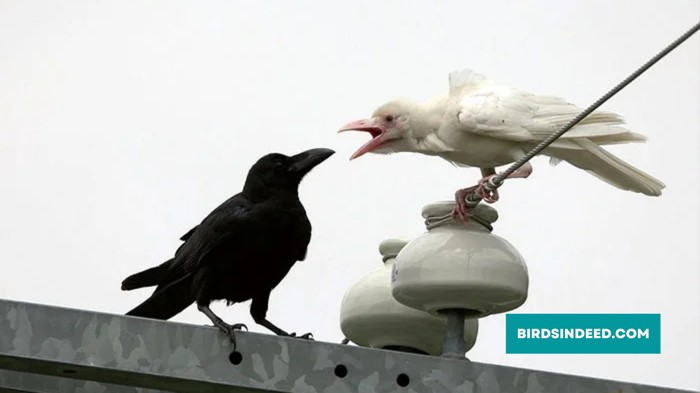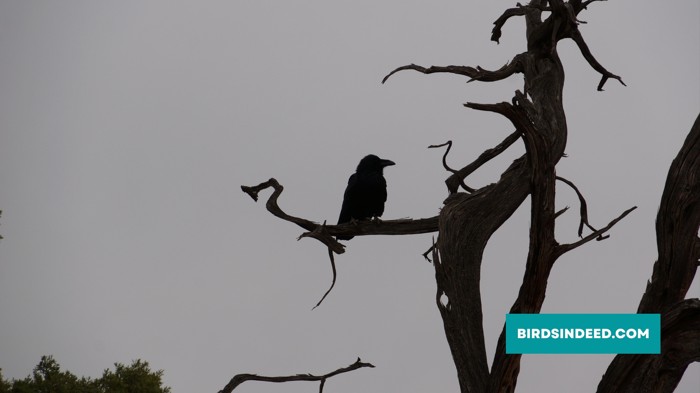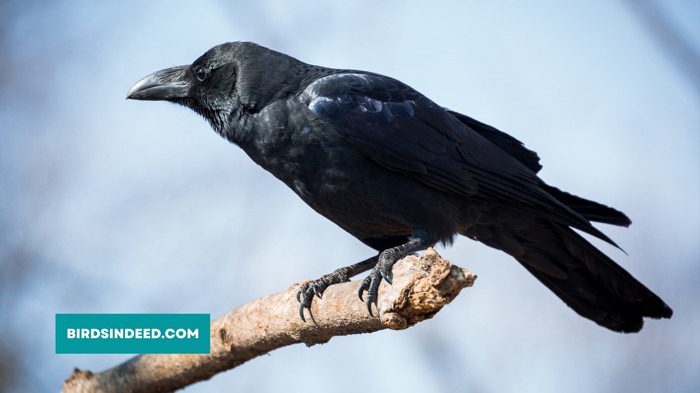The jet-black feathers of a crow are unmatched in their beauty. They became associated with bad luck or death because of their color, and they have a special position in folklore. So, are crows black because they originate from a far, frightening spiritual location, or is there anything much less ominous about their coloring? Let’s find out!
Crows and other corvids have been the subject of stories since people first started storytelling. Given that crows are widespread around the world and remain in close contact with humans now as they did a century ago, this should not come as a surprise. Crows have gotten into the most private aspects of our existence, whether they are sharing or stealing the food we produce, eating the soft tissues of the dead, or just making us pleased with their company.
Even when we suffer from pandemics or famine, they continue to wander the world covered in black while bearing the light of life. It is this contrast, I assume, that led our ancestors to believe that humans must have a closer connection to crows than other birds. They have been mentioned in the earliest tales describing how the realities of the globe came to be, whether they concern India, Rome, the Middle East, or North America.
Contents
Why Are Crows Black?
Crows are black due to melanin, a chemical found in their feathers, skin, and beaks. It is found in practically all bird species. Crows have a lot of eumelanin, which gives them their black color. They may appear dramatically different to the other birds because their eyesight is so different from ours.
Are Crows Always Black?
No, not all crows are entirely black, with the exception of American crows. Like house crows in India, some of them are various colors of black with distinguishing gray patterns, while others can have feathers that are gray, light gray, brown, blue, cream, or even pink.

There may possibly be some albino crows that are entirely white. Due to the absence of dark pigment-producing melanin, they typically turn white. Some of them, meanwhile, exhibit some white spots on various body areas, making them half-white.
Scientific Explanation
The melanin that gives crows their dark coloring is a natural component of their bodies. Furthermore, since black objects reflect no color, they look black because they absorb all light frequencies.
Melanin, the pigment responsible for our skin and hair color, is also the chemical that gives the feathers and skin of birds their color. Although it is not exactly the same, the melanin in our bodies belongs to the same family of chemicals as the melanin found in bird skin and feathers.

A pigment is a substance that gives color to other materials, and melanin is one such pigment. The two types of melanin are eumelanin and phaeomelanin. Different bird colors are caused by each of them.
Phaeomelanin creates color tones like rufous, chestnut, or golden hues, while eumelanin creates black and gray (as well as all shades in between). The amount of melanin in a bird’s skin or feathers determines how dark it will be. Eumelanin is present in large quantities in the bodies of crows.
The DNA of crows may have undergone a mutation in the past. With that mutation, they were able to reproduce more easily and passed it on to future generations. This is most likely the cause of the long-lasting black color of crows.
Read: Do Crows Attack Owls? [Find Out The Facts]
Native American Mythology
Native American mythology holds that the crow was born into the world wearing every color of the rainbow. All other birds and animals at the time were black. The crow was mocked by them since he was an outsider. Crow was quite dejected.
To look more like them, he shook himself until all the colors flew out and landed on various animals and birds, such as blue jays covered in blue, robins in orange, and woodpeckers in a touch of red. All that remained of the crow’s color was black.
Greek & Roman Mythology
Apollo was the son of Zeus, the most powerful Greek deity, and he had a significant, though turbulent, relationship with crows. Corone, the Greek word for crow, derives from Coronis, the name of Apollo’s mistress. Although Coronis and Apollo had been lovers, she abandoned him to wed a mortal, Ischys, in the version of this tale based on Apollodorus. Infuriated, Apollo set fire to the crow’s feathers and then burned Coronis to death after the crow (which was white at that time) informed him about the marriage. It is probable that the Greeks imagined a mated pair of crows as a depiction of the forbidden love between Coronis and Ischys as Coronis is depicted in other versions as the black crow.
Chinese Mythology
According to an ancient Chinese story, crows came from phoenixes. Phoenixes happen to live on the phoenix tree. One day, the tree is on fire while some phoenixes were sleeping on it. All but one phoenix managed to flee the fire. The feather of the phoenix was burnt by the fire and turned black. The black phoenix was once referred to as the ‘crow’ because it is so unattractive. However, such assertion might be true in western nations.
Jewish Mythology
Adam and Eve did not know what to do with the body of their son Abel after he passed away, according to the Yalkut Shimoni, a compilation of the Hebrew Bible produced in the 13th century. When the crow noticed their anguish, he killed one of his friends and used the body to demonstrate to the distraught couple how to bury the body. As a gesture of gratitude for the crow’s benevolence, God feeds their babies until their feathers turn black.
The Benefits of Being Black
Besides being the reason behind a crow’s black color, melanin also provides them and other birds with some additional advantages. In the following manner, we’ll discuss the benefits that crows enjoy for being black:

- Physical strength: Melanin strengthens the bodily components in which it is present in addition to acting as a pigment. This explains why many birds have dark wingtips on their flight feathers. These feathers are more durable because of the additional melanin there. The wing’s tip needs to be stronger because it is essential for flight and receives greater sun exposure. Crows frequently scavenge carcasses, therefore they must have powerful beaks. This may be the cause of the increased melanin in their beaks to give them the extra toughness required for such a diet.
- Protection from the weather: Crows are able to withstand the bitter winter cold because of their black plumage. As you may expect, black feathers can hold the most heat. Their black feathers enable them to survive when they roost in riparian areas. Although a crow’s black feathers will become hotter, they are exceptionally well insulated, so little of that heat will reach the skin. Crows will stay more comfortable in a light breeze than white birds. At the surface of their dark feathers, where they are immediately emitted back into the air, light and heat are absorbed.
- Parasite protection: Because of their black feathers, crows are immune to parasites. This does not imply that they are parasite-free. In fact, their black feathers make them prone to parasites. The most common illness affecting crows is the West Nile Virus caused by parasites.
- Bacteria-resistant: Melanin has antibacterial properties. Bacteria can harm the feathers of birds in humid regions. Many birds that reside in such temperatures have darker plumage than birds that live in a drier climate. It is advantageous to have this additional protection because many crows inhabit humid locations.
- Blend in with nature: Because crows have black feathers, they can blend in when resting at night. Crows typically reside in large groups with fledglings and yearlings. As a result, they must keep a close eye out for potential predators. Black feathers are quite beneficial to them.
Also read: The Australian Raven: A Bird To Watch Out For
Do Crows Bring Bad Luck?
Crows are not bad luck except if you think they are. Crows are sometimes seen as ill omens or death foreboders in several civilizations. Because they devour dead animals and nest in cemeteries, crows are often associated with death. As opposed to what some people might think, this behavior is typical for these birds.

Crows have a bad reputation because of a multitude of factors, such as their love of eating dead animals, their tendency to roam around graveyards, and others. They are carnivorous, and in many cultures, this has led to the misconception that they are not only consuming the dead’s flesh but also their souls. Crows were then considered to be home to the spirits of the dead.
There are good reasons why other birds, like crows and ravens, also choose to linger out near graves. First of all, cemeteries are typically large, open locations with lots of trees, and crows prefer to roost in large groups. Secondly, the grass is maintained neatly short at cemeteries, which makes it simple for crows to find insects to consume.
Because they have a high level of intelligence, crows are capable of remembering human faces. A person can be remembered not only by the individual but also by future generations due to their familiarity. Crows will defend themselves against someone who has harmed them.
If you mistreat a crow, not alone will it attack you, but so will the rest of its family. Another possible explanation for why crows are considered unlucky is their tendency to carry grudges.
The reverse is also true; if you make friends with a crow, you will have them for life. That bird will identify you in its succeeding generations and become friends with you.
Do Crows See Themselves As Black?
Crows may not appear black to other crows because they can distinguish between a wider range of light spectrums than humans. Other crows or possibly other bird species may see them differently than humans do.
Most crows, especially American crows, appear black to humans. In our opinion, crows of both sexes have similar appearances. But crows, on the other hand, can distinguish between their males and females by using their own unique selection of colors and patterns.
Conclusion
In conclusion, melanin, which produces dark pigment, is what gives crows their black color. In my opinion, the myths and tales regarding how crows turned black are fictional. They are only myths that have no basis as a matter of fact.
Crows have thus provided a canvas on which prehistoric people around the world painted their interpretations of life, whether it is the color of crows or the personal mysteries of human mortality. However, we hope you have gained a lot of knowledge regarding why crows are black and whether they may be found in other shades in addition to black.
Hyeat is the founder of Birds Indeed, a blog dedicated to all things avian. With a passion for birds and a deep understanding of their behavior, Hyeat shares their knowledge and experiences with readers. Join Hyeat on their journey to learn more about the diverse and beautiful world of birds.







